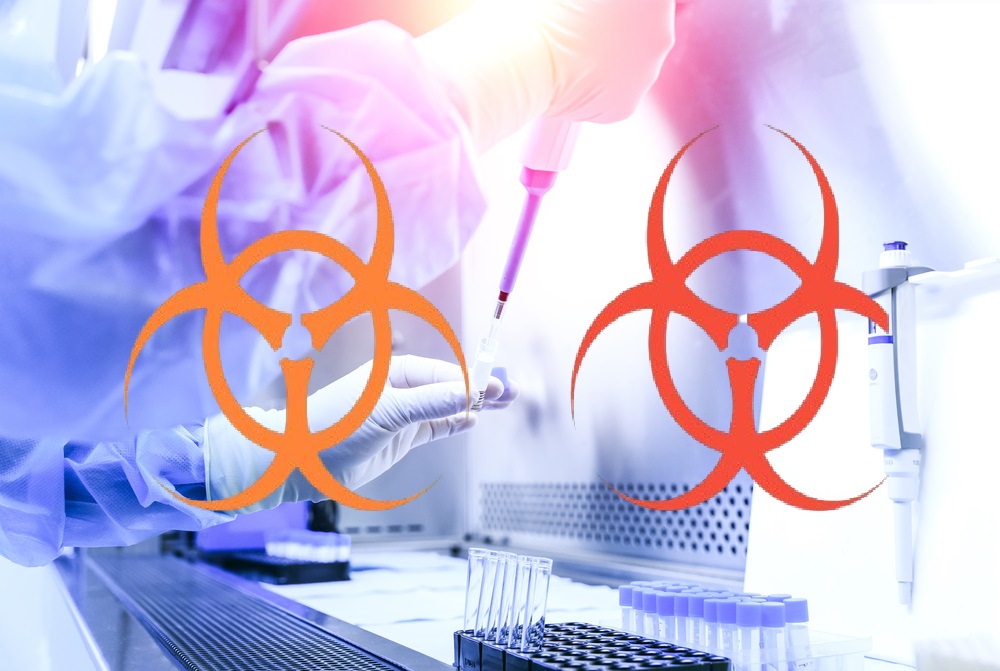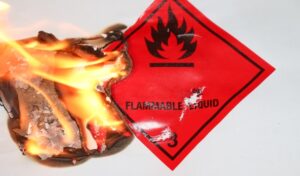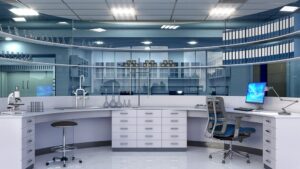
High containment lab design is no small task. These specialized environments, often classified as Biosafety Level 3 (BSL-3) or Biosafety Level 4 (BSL-4) facilities, are critical for research and diagnostics involving hazardous pathogens.
The stakes are high: improper design can lead to contamination risks, endangering not only the research but also the personnel and the broader public. To meet the rigorous safety and containment standards required for these labs, every aspect of the design must be carefully considered, from airflow systems to decontamination processes.
One of the most critical yet often overlooked aspects of designing BSL-3 and BSL-4 labs is the choice of furniture and layout. Selecting the right materials and optimizing the laboratory’s layout can greatly enhance both safety and efficiency, ensuring the lab operates seamlessly while adhering to strict containment protocols.
In this article, we’ll explore essential furniture and layout tips for high containment labs, focusing on how to meet the unique challenges of these demanding environments.
Understanding High Containment Requirements

High containment laboratories, particularly those classified as Biosafety Level 3 (BSL-3) and Biosafety Level 4 (BSL-4), are designed to handle the most dangerous and infectious biological agents. These labs must adhere to strict protocols to protect not only the scientists working inside them, but also the surrounding environment.
Understanding the specific containment requirements for these labs is crucial when designing their layout and choosing appropriate furniture.
1. Biosafety Levels and Protocols
BSL-3 labs handle agents that can cause serious and potentially lethal infections through inhalation, such as tuberculosis or SARS. These labs require controlled access, specialized ventilation systems, and sealed work areas to prevent pathogens from escaping.
BSL-4 labs, on the other hand, deal with the most hazardous and exotic pathogens, such as the Ebola and Marburg viruses, for which no known treatments exist. These labs are highly restricted and must operate in complete isolation, often requiring researchers to wear full-body positive-pressure suits.
2. Strict Guidelines and Regulations
The design of high containment labs is governed by international and national safety regulations. Guidelines from organizations such as the Centers for Disease Control and Prevention (CDC) and the World Health Organization (WHO) outline the specific requirements for airflow, decontamination, and containment systems.
For instance, BSL-3 and BSL-4 labs must maintain negative air pressure to ensure that air flows inward, preventing pathogens from escaping into non-contained areas. Additionally, these labs require advanced filtration systems, such as HEPA filters, to clean the air and prevent contaminants from spreading.
3. Critical Safety Features
Key features of high containment labs include seamless surfaces to reduce contamination, airtight seals on doors and windows, and hands-free equipment to minimize contact.
Workspaces must be designed to ensure minimal cross-contamination and allow for decontamination procedures, such as chemical sprays or autoclaving. Ensuring that the layout of the lab supports these essential safety features is foundational to designing a functional high containment environment.
Understanding these containment requirements forms the backbone of a successful lab design. With the right infrastructure and protocols in place, high containment labs can effectively minimize the risk of exposure to harmful pathogens while maintaining a safe and efficient workspace for scientific research.
Furniture Considerations for High Containment Labs

Choosing the correct furniture for high containment laboratories is not merely about function or aesthetics—it’s about ensuring safety, compliance, and ease of operation in an environment where the stakes are incredibly high.
The furniture in these labs must be durable, resistant to contamination, and capable of supporting the stringent decontamination procedures required in Biosafety Level 3 (BSL-3) and Level 4 (BSL-4) environments. Here are key considerations when selecting furniture for these specialized labs:
1. Material Choice
In high containment labs, furniture must be made from materials that are non-porous, easy to clean, and resistant to both chemicals and frequent decontamination. Stainless steel is the most common choice due to its strength, durability, and resistance to corrosive agents.
It is also non-reactive and non-porous, which prevents the absorption of hazardous chemicals or biological agents. Additionally, other materials like epoxy-coated steel and certain types of plastics may be used, but they must meet stringent chemical resistance standards and be easy to disinfect.
2. Modular Design for Flexibility
Flexibility in furniture design is critical for high containment labs, where research needs may evolve, or equipment may need to be moved frequently.
Modular furniture systems, such as workbenches, shelving units, and storage cabinets, offer adaptability, allowing the lab to be reconfigured quickly without compromising containment protocols. This flexibility is also crucial in enabling researchers to maintain smooth workflows while keeping work areas organized and safe.
3. Storage Solutions
High-containment labs require specialized storage solutions that can accommodate sensitive materials, including biological samples, chemicals, and reagents.
Secure, lockable cabinets with smooth, non-porous surfaces are essential for safely storing hazardous materials. Additionally, shelving units and storage areas should be decontamination-friendly, with seamless construction to prevent contamination buildup and make cleaning easier. Storage furniture must also be placed in well-ventilated areas to avoid the buildup of harmful gases or vapors.
4. Decontamination Compatibility
All furniture in high containment labs must be designed with decontamination procedures in mind. This means ensuring that workbenches, chairs, and storage units are easy to clean and able to withstand repeated exposure to harsh chemicals or high-heat decontamination processes, such as autoclaving.
Chairs and stools, for instance, should be made of non-absorbent materials and designed without complex seams or upholstery that could trap contaminants. Similarly, work surfaces should be seamless and resistant to both chemical and biological exposure, ensuring they remain safe and functional over time.

5. Ergonomics and Safety
While safety and containment are top priorities, comfort and ergonomics also play a vital role in high containment lab furniture. Researchers often work long hours in these labs, so furniture should support ergonomic postures and reduce physical strain.
Adjustable height workstations and ergonomic chairs can help maintain productivity and safety, ensuring that lab personnel can focus on their tasks without risking fatigue or injury. In addition, the layout of furniture should allow for clear, unobstructed pathways to emergency exits and safety equipment, such as eyewash stations and safety showers.
Summary
Selecting the right furniture for high-containment labs involves balancing safety, functionality, and flexibility. The materials used must be durable, easy to clean, and capable of withstanding rigorous decontamination processes.
Modular furniture designs offer flexibility, allowing the lab to adapt to changing needs while maintaining containment standards. By choosing decontamination-friendly, ergonomic furniture, high-containment labs can create a safe, efficient, and compliant workspace that meets the unique demands of these environments.
Optimizing Layout for Safety and Efficiency
The layout of a high containment laboratory is one of the most crucial elements in ensuring both the safety of personnel and the efficiency of daily operations. Designing a functional, workflow-friendly space while maintaining strict containment protocols requires careful planning. By optimizing the layout, high containment labs can minimize contamination risks, streamline research activities, and respond effectively in emergencies.
1. Zoning for Containment
High-containment labs need to be strategically divided into distinct zones based on levels of contamination risk. This typically involves the separation of areas into “clean” and “contaminated” zones, with clear physical and procedural barriers between them.
Contaminated zones—where hazardous materials are handled—must be isolated to prevent cross-contamination. For example, designing rooms with progressively higher containment levels ensures that the most dangerous pathogens are handled in highly controlled spaces with restricted access.
Additionally, airflow plays a critical role in zoning. High containment labs must maintain negative air pressure in hazardous areas to ensure air only flows inward, preventing pathogens from escaping. Proper placement of airlocks and ventilation systems is key to maintaining this containment, and ensuring that airflow patterns do not interfere with equipment or disrupt the lab’s operations.

2. Minimizing Cross-Contamination
One of the primary goals in high-containment lab design is to minimize the risk of cross-contamination. This can be achieved by creating separate entry and exit points for personnel and materials.
For instance, “dirty” areas (where potentially hazardous materials are handled) should have dedicated exits for waste disposal and decontamination, while “clean” areas should have controlled entry points to ensure contaminants do not spread into lower-risk zones.
The flow of personnel, samples, and equipment should follow a unidirectional path. This means that researchers should enter the lab through one door, perform their tasks, and exit through another, without retracing their steps.
Establishing designated areas for donning and doffing personal protective equipment (PPE) near the lab entrance and exit ensures that all gear is put on or removed in the correct order to avoid accidental exposure.
3. Ergonomics and Space Efficiency
The layout of a high containment lab must promote smooth, efficient workflows. This includes positioning key equipment—such as biosafety cabinets, fume hoods, and autoclaves—within easy reach of workstations to reduce unnecessary movement and time spent transferring materials between areas.
By minimizing the distance between work zones, the risk of accidental contamination or exposure can be reduced, and lab operations can flow more efficiently.
Additionally, the layout must provide flexibility to accommodate various research activities. Modular workstations and movable partitions allow the space to be reconfigured as needed, without compromising safety protocols.
This flexibility ensures that the lab can adapt to evolving research projects, the introduction of new equipment, or changes in personnel, all while maintaining optimal containment.
4. Accessibility and Safety Features
Safety is at the heart of high-containment lab design, and the layout must include clear, accessible paths to emergency exits, safety equipment, and decontamination stations.
Pathways should remain unobstructed at all times to allow for quick evacuations if required. Strategic placement of safety showers, eyewash stations, and fire extinguishers ensures that personnel can reach them without delay during an emergency.
Moreover, the lab must be designed to reduce bottlenecks and congestion in high-traffic areas. Creating wide, unobstructed corridors and ensuring adequate space around workstations prevents overcrowding and makes it easier for personnel to move safely throughout the lab.
5. Balancing Safety and Workflow
While containment is the top priority, it should not compromise the lab’s ability to function effectively. A well-optimized layout balances safety features with the practical needs of research, ensuring that personnel can work efficiently while minimizing the risk of contamination or exposure.
By integrating thoughtful zoning, efficient workflows, and strategically placed safety features, high containment labs can meet the rigorous demands of both safety and scientific progress.
Specialized Equipment Placement

The placement of specialized equipment in high containment laboratories is vital to maintaining safety, workflow efficiency, and proper containment of hazardous materials. Properly positioning equipment such as biosafety cabinets, fume hoods, autoclaves, and storage units can help ensure that lab personnel work in a controlled, safe environment while adhering to containment protocols.
The placement of this equipment must take into account factors such as airflow control, ease of access, and contamination prevention.
1. Isolation Units and Enclosures
Biosafety cabinets (BSCs) and fume hoods are essential pieces of equipment in high-containment labs, as they provide a controlled environment for handling dangerous pathogens and volatile chemicals. The placement of these units is crucial to maintaining effective containment.
BSCs and fume hoods should be strategically placed along the perimeter of the lab, away from high-traffic areas, to avoid airflow disturbances that could compromise their function. These units should also be positioned in locations where they are easily accessible to researchers without requiring them to pass through contaminated zones or cross clean areas with hazardous materials.
Additionally, airflow within the lab should be carefully planned to ensure that these units maintain proper air exchange rates, helping to prevent the escape of pathogens or chemicals.
2. Decontamination Areas
Autoclaves and chemical decontamination stations are integral to the safety protocols of high containment labs. These units must be located near exit points in the containment zones to allow for easy and thorough decontamination of equipment, materials, and waste before they leave the lab.
Autoclaves should be placed in designated decontamination areas, with ample space for staff to safely load and unload items without risking cross-contamination. Placing these units close to the lab’s waste management systems ensures efficient disposal of hazardous materials, minimizing the risk of contamination during transport within the lab.
Additionally, chemical decontamination stations, such as those used for disinfecting surfaces and tools, should be positioned at key access points where researchers frequently enter or exit containment zones. These stations must be easily accessible but not obstruct the flow of personnel or materials through the lab.
3. Storage for Hazardous Materials
Secure storage of hazardous biological and chemical materials is a top priority in high-containment labs. Storage units, such as freezers, refrigerators, and chemical cabinets, should be placed in well-ventilated areas, away from busy workstations, to reduce the risk of accidental exposure or contamination.
Storage units must also be placed near the appropriate workstations to streamline workflow. For example, biological sample freezers should be located close to biosafety cabinets, allowing researchers to transfer samples quickly and safely without unnecessary exposure to open lab environments.
Additionally, chemical storage cabinets should be positioned in ventilated zones to prevent harmful vapors from accumulating in work areas.
4. Ventilation and Safety Systems Integration
Many pieces of specialized equipment in high-containment labs require integration with the lab’s overall ventilation and safety systems.
For example, biosafety cabinets and fume hoods must be connected to the lab’s HEPA filtration system to ensure that hazardous particles are safely filtered and removed from the air. Similarly, chemical storage units should be linked to exhaust systems to prevent the buildup of toxic fumes.
When placing specialized equipment, careful consideration must be given to how these systems interact with the lab’s overall containment strategy. Poor equipment placement can result in airflow disruptions, leading to potential containment breaches. Therefore, it is essential to coordinate equipment placement with ventilation systems, ensuring that hazardous materials are contained and removed efficiently.

5. Ensuring Equipment Accessibility and Safety
Finally, specialized equipment must be positioned with safety and accessibility in mind. Emergency equipment, such as safety showers, eyewash stations, and fire extinguishers, should be located near areas where hazardous work is being performed.
Pathways leading to and from specialized equipment should be kept clear to allow for quick access in case of an emergency. Additionally, equipment that requires regular maintenance or cleaning should be positioned in a way that allows staff to perform these tasks without compromising containment or workflow.
Summary
Proper placement of specialized equipment in high-containment labs is essential for maintaining safety, efficiency, and containment. From biosafety cabinets to storage units and decontamination stations, every piece of equipment must be thoughtfully positioned to support the lab’s operations while adhering to strict containment protocols.
By carefully considering airflow, accessibility, and integration with safety systems, high containment labs can ensure that specialized equipment enhances both safety and research outcomes.
Additional Reading: Clean Room Laboratory Essentials: Maintaining a Contaminant-Free Environment
Innovative Design Trends for High Containment Labs

As research evolves and the need for higher levels of safety and efficiency grows, high-containment labs are embracing innovative design trends that improve both functionality and safety. Advances in technology, automation, and sustainability are reshaping the way these labs operate, making them more efficient, adaptable, and environmentally responsible without compromising the strict protocols required for containment.
Here are some of the leading design trends transforming high containment laboratories today.
1. Automation and Smart Labs
One of the most significant trends in high-containment lab design is the increasing use of automation and smart technology. Automated systems are being integrated into lab workflows to reduce human exposure to hazardous materials and improve accuracy.
For example, robotic arms can handle repetitive tasks such as sample processing, reducing the need for direct human contact with dangerous pathogens. Automation also helps minimize errors, enhancing both safety and efficiency.
Smart lab technologies, such as real-time monitoring systems, are becoming more prevalent in high containment labs. These systems can monitor factors like airflow, temperature, and humidity, alerting personnel to any deviations that could compromise containment.
Additionally, smart furniture, such as height-adjustable workstations and mobile lab benches, can be integrated with digital systems to improve ergonomics and workflow flexibility. These innovations allow labs to operate more safely and efficiently, while reducing the risk of contamination.
2. Touchless Technology for Enhanced Safety
With the rise of touchless technology, high containment labs are becoming safer by reducing the number of surfaces that personnel need to touch. This trend is particularly important in environments where minimizing contact is crucial for preventing the spread of contamination.
Hands-free doors, touchless faucets, and motion-activated lighting systems are now standard features in many high-containment labs. These technologies help limit the spread of contaminants by reducing the number of surfaces that could harbor pathogens.
Additionally, touchless controls for biosafety cabinets and fume hoods allow researchers to operate these critical systems without physically touching them, further enhancing containment and safety. The integration of touchless technologies also contributes to the lab’s overall hygiene and ease of maintenance.

3. Sustainability in High Containment Labs
Sustainability has become a major focus in modern lab design, even in high containment environments where safety is paramount. Labs are notorious for their high energy consumption, particularly due to the need for advanced ventilation and air filtration systems.
However, many high-containment labs are now adopting energy-efficient HVAC systems, designed to reduce energy use while maintaining the necessary negative pressure and filtration standards. Heat recovery systems are another sustainable innovation, capturing waste heat from exhaust air to reduce energy costs.
Furniture and building materials are also being selected with sustainability in mind. Non-toxic, recyclable materials are becoming popular choices for lab construction and furniture, reducing the lab’s environmental impact. In addition, some labs are exploring the use of green building certifications, such as LEED, to ensure that their facilities meet high environmental standards without compromising safety.
4. Flexible and Adaptable Lab Spaces
As the nature of scientific research continues to evolve, so too does the need for labs that can quickly adapt to new research needs and technologies.
Modular design is a growing trend in high-containment labs, allowing workspaces to be reconfigured as needed without extensive renovations. Movable workstations, modular storage units, and mobile lab equipment provide the flexibility to accommodate new research projects, changes in personnel, or upgrades in technology.
These adaptable spaces improve workflow efficiency and reduce downtime when labs need to shift focus or accommodate different containment levels. Flexibility in design allows high-containment labs to stay current with evolving scientific demands while maintaining safety and compliance with regulatory standards.
5. Advanced Materials for Improved Safety
The materials used in high containment labs are also seeing innovation, with new developments focused on improving safety and durability.
For example, antimicrobial surfaces are being integrated into workbenches, storage units, and even flooring to help reduce the risk of contamination. These materials are designed to inhibit the growth of bacteria, viruses, and fungi, providing an additional layer of protection in labs where pathogens are handled.
Furthermore, advancements in chemical-resistant coatings and non-porous materials ensure that furniture and equipment can withstand harsh decontamination procedures while remaining functional and safe. These materials are not only durable, but also reduce the need for frequent replacements, contributing to the sustainability and cost-efficiency of lab operations.

6. Virtual and Augmented Reality for Training and Safety
Virtual and augmented reality (VR and AR) technologies are emerging as valuable tools in high-containment lab design and training. VR simulations allow researchers and lab personnel to practice procedures and safety protocols in a controlled, virtual environment before stepping into a real lab. This reduces the risk of human error during critical tasks and enhances personnel preparedness.
AR technology can also be used for real-time support in high containment labs, overlaying digital information onto the physical workspace to guide researchers through complex procedures. This technology is particularly useful for training new staff, conducting inspections, or troubleshooting equipment without disrupting ongoing lab work.
Summary
Innovative design trends are revolutionizing high-containment labs, making them safer, more efficient, and environmentally responsible. From automation and smart technology to touchless systems and sustainable materials, these trends are helping labs meet the growing demands of modern scientific research while ensuring the highest standards of safety and containment.
By embracing these innovations, high containment labs can remain at the forefront of both scientific progress and safety, adapting to the ever-changing landscape of laboratory science.
Conclusion
Designing high containment laboratories requires a careful balance between safety, efficiency, and adaptability. Every decision, from the materials used for furniture to the placement of specialized equipment, plays a crucial role in maintaining containment and ensuring smooth lab operations.
The layout and design trends for high-containment labs are evolving rapidly, incorporating advanced technologies and sustainability practices to enhance both safety and functionality. By staying informed about these innovations and implementing best practices, lab designers and operators can create environments that not only meet current standards, but are also adaptable to future challenges in research and safety.
If you’re planning to design or upgrade a high containment lab, the complexities of ensuring safety and efficiency require expert guidance. Contact Genie Scientific today to consult our team of specialists, who can help you optimize your lab’s layout, select the right furniture, and integrate cutting-edge technology.
Let us help you create a laboratory that meets your unique needs while exceeding safety standards—ensuring your lab is prepared for the future of scientific research.




